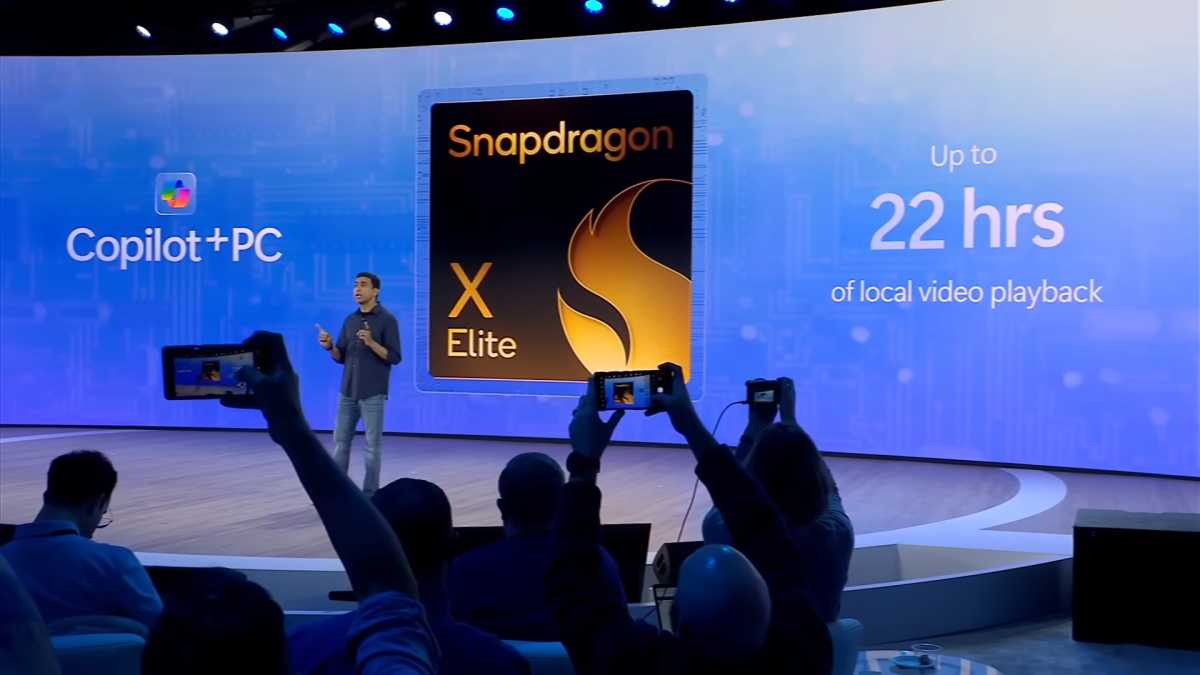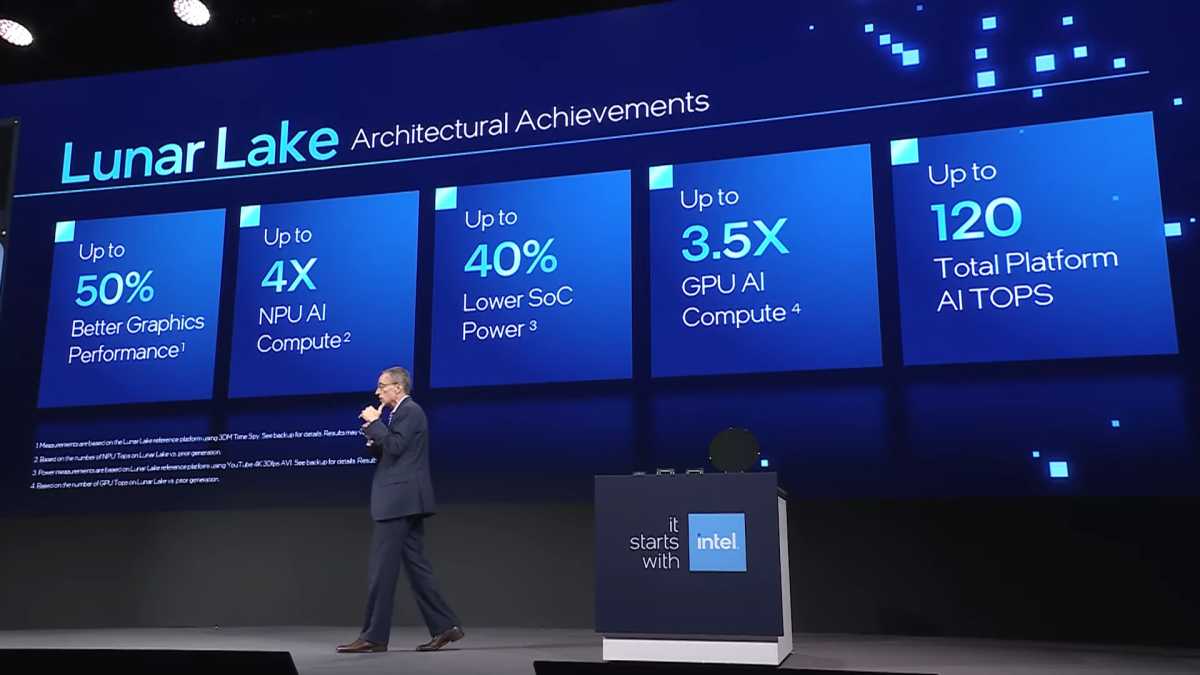Intel and AMD need to deliver better laptop battery life – fast
At Computex 2024, everyone was talking about AI again. Intel’s Lunar Lake hardware and AMD’s Strix Point chips will deliver faster AI performance, with upgraded neural processing units (NPUs) that meet and exceed Microsoft’s Copilot+ PC requirements. That’s great.
But the big promise of Qualcomm’s soon-to-be-released line of Snapdragon X Elite-powered laptops is the huge battery life numbers we’re being promised over Intel and AMD-powered laptops.
“We know we haven’t necessarily been the highest battery life design point,” said Intel’s Dan Rogers in an interview with PCWorld’s Mark Hachman at Computex.
Intel is talking like it’s solved the problem — but we haven’t heard any concrete numbers yet.
Now, the race is on. At Computex, Arm CEO Rene Haas told us Apple “woke up the industry on the art of the possible.” After all, Apple’s Macs once used Intel CPUs. The company dumped them for more power-efficient Arm chips. Now, Intel and AMD need to prove they can deliver long battery life in laptops, too — they don’t want a repeat of what happened to the Mac market happening in the light-and-portable Windows laptop market.
Why Snapdragon PCs are such a threat

Microsoft

Microsoft
Microsoft
With Snapdragon X, Qualcomm is hitting Intel and AMD where it hurts — in the battery life.
Microsoft, Qualcomm, Arm, and PC manufacturers are focusing on the AI performance when it comes to marketing those new Snapdragon X-powered Copilot+ laptops. It is, as Arm’s CEO put it, a good upgrade story that gives these Arm-powered PC “a great kind of tailwind” — one that makes people want to buy a new machine and start taking a look at these new laptops.
But the real big story for PC users is the battery life. We haven’t gotten our hands on any of these Snapdragon X-powered PCs just yet, so we can’t evaluate the battery life claims — we look forward to doing that in the coming weeks. Still, Qualcomm is talking up some huge numbers. Manufacturers are promising up to 22 hours of battery life on some of these systems. Internal documents from Dell claim Snapdragon-powered laptops may nearly double the battery life offered by Intel-powered laptops.
AMD didn’t talk up battery life improvements

AMD

AMD
AMD
Unfortunately, AMD wasn’t big on talking battery life at Computex. AMD is focusing hard on powerful high-end desktop processors with its Ryzen 9000 processors. On the laptop side, AMD is all about performance, too: Both AI performance and all-around performance with its Ryzen AI 300 series processors.
This all sounds great — but one thing AMD isn’t talking about much is battery life. AMD has a good story if you’re looking for a powerful NPU for AI tasks, a high-end desktop processor, or performance boosts in a gaming laptop.
AMD isn’t pitching its new processors as enabling a huge upgrade in battery life, like Intel and Qualcomm are. Of course, we’ll have to see what happens when new laptops with these processors are released.
We interviewed Donny Woligroski, Senior Technical Marketing Manager at AMD, who had a little bit to say about battery life — saying that it was up to its hardware partners what gets built.
That’s fair, and maybe it’s a smart move for AMD to focus more on high-end performance and leave Intel and Qualcomm to fight over the battery life crown. But that does mean AMD might not be the company manufacturers turn to for thin-and-light laptops — not unless it can deliver the kind of power efficiency numbers Intel and Qualcomm are talking up.
Intel talked about power efficiency — but not battery lifeIntel had a lot to say about Lunar Lake at Computex 2024. Intel’s new hardware platform prioritizes power efficiency and AI performance. Yes, these will truly be modern “AI PCs.”


Intel

Intel
Intel
Insert a record scratch here. Yes, we heard all these things about Intel’s Meteor Lake CPUs earlier this year. But, in many of our benchmarks, Meteor Lake hasn’t really delivered the big battery life gains we would hope for. And that Meteor Lake NPU — well, it’s not powerful enough to run those new Copilot+ PC features.
Still, Intel is making a variety of changes aimed at efficiency. For example, there’s now something called an “OS containment zone” that lets the operating system force a program to run only on low-power efficiency cores (E-cores) and never touch higher-power P-cores. Intel said this cuts the power usage of Microsoft Teams by 35 percent on a Lunar Lake chip versus a Meteor Lake chip.
“Our mission with Lunar Lake is we wanted to build the most power-efficient x86 architecture there is — period. And we’re feeling pretty confident,” said Intel’s Dan Rogers in our interview with him and Robert Hallock at Computex.
Intel had a lot to say about this sort of thing — how on-package memory will boost energy efficiency, the changes to Lunar’s Lake’s architecture, the elimination of hyperthreading, the changes to the Intel Thread Director, and how it will all come together for more performance and power efficiency.
For example, Intel said those low-power E-cores in Lunar Lake can be run in low-power mode using one-third the power of a Meteor Lake E-Core, or they can be run in a higher-power mode where they offer 1.7 times the performance.
That’s all great, but one thing was absent: Any talk of concrete battery life numbers, since Intel didn’t announce specific products (read: individual CPUs) and only detailed the underlying Lunar Lake architectural design. (This Intel fact sheet does say “up to 60% battery life in real life usage,” which is the closest to a concrete figure I can find.)
We don’t know what these laptops will deliver yet — though, to be fair, we don’t really know whether those Snapdragon X Elite chips will live up to the hype until we put them through our benchmarks, either.
Either way, Intel will need to deliver big battery life games to compete with Qualcomm’s Snapdragon X Elite. Intel wants people to compare Snapdragon X Elite to its upcoming Lunar Lake hardware, not its current Meteor Lake hardware — and Intel will need to deliver something impressive to avoid the perception that it’s far behind Arm-based Windows laptops on battery life.
Soon Intel and AMD will have to worry about more than QualcommEverything we’ve heard suggests Qualcomm’s Snapdragon hardware will be a huge upgrade. But we really have to test these things for ourselves soon.
For example: Everyone’s impressed by Microsoft saying the 16-inch Surface Laptop with Snapdragon will get 22 hours of battery life. But Microsoft also says that the 15-inch Intel Meteor Lake-powered Surface Laptop 6 for Business gets 19 hours of battery life. So, going by the official numbers, there’s not much of a boost in battery life coming over Meteor Lake — not unless those manufacturer-provided battery life numbers were a little too optimistic. In my experience, those manufacturer-provided numbers are usually too optimistic — but that means Snapdragon may not deliver the 22 hours people are talking up, either.
Either way, if Qualcomm doesn’t deliver, another company might soon. It’s rumored that Microsoft and Qualcomm had a confidential agreement that Qualcomm is the only company allowed to create Arm hardware for Windows PCs. That would explain why we haven’t seen any other companies throw their hat into the ring — at least since the days of the Surface RT and Surface 2, which were powered by Nvidia hardware. It’s also rumored that that exclusivity agreement ends this year.
Arm’s CEO Rene Haas told us that all this talk about the exclusivity agreement — and its expiration — is true according to all the rumors he’s heard. This means we could see a flood of Arm chips for Windows laptops that Intel and AMD need to compete with.
To do it, both Intel and AMD will need to have a more competitive battery life story. After all, Qualcomm is gunning for half the PC market over the next five years.
CPUs and Processors, Laptops